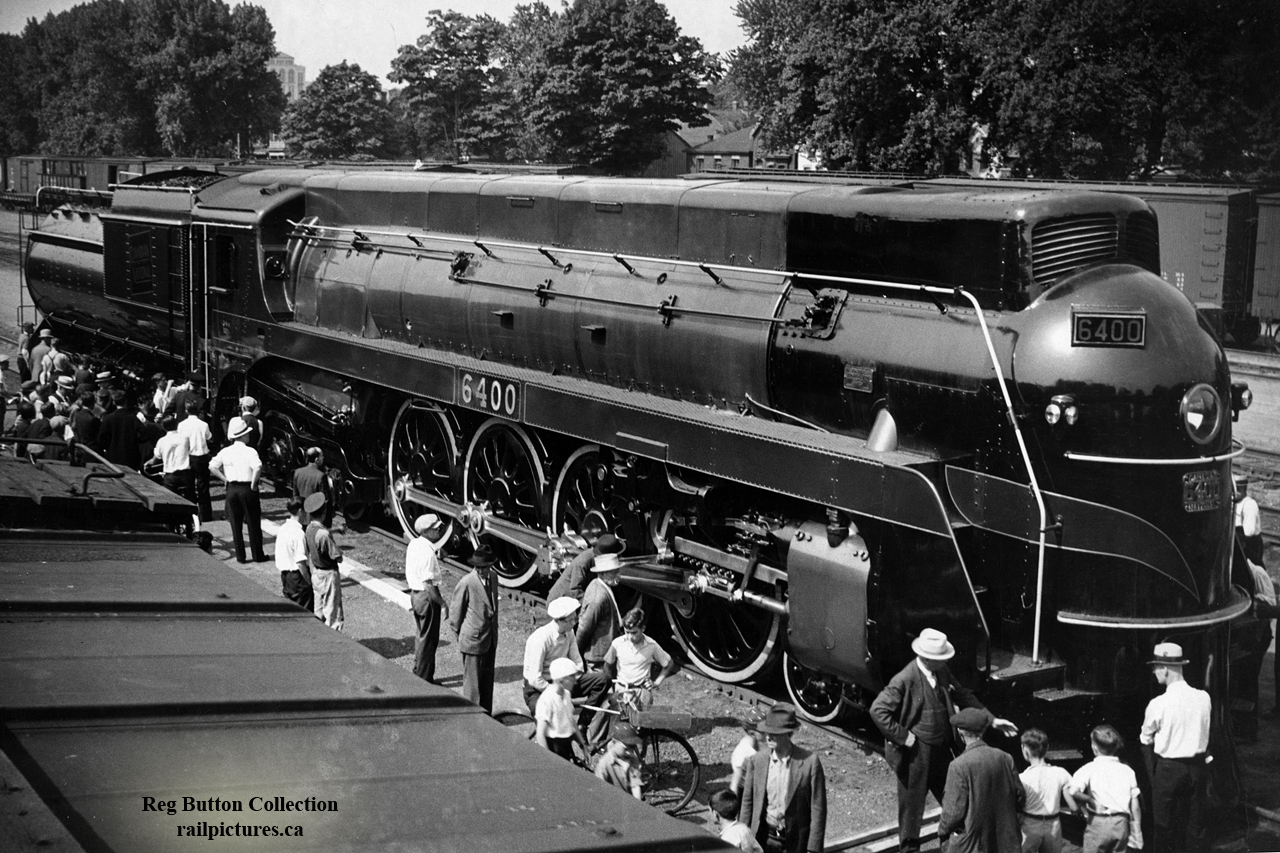|
Caption: Newly built CNR 6400, one of five U-4-a 4-8-4 locomotives built by MLW in 1936, is seen on public display at the Ferguson Avenue freight shed in Hamilton. The streamlined Confederations were used in Ontario/Quebec passenger service until their retirements in 1960/1961. CN 6400 is the sole survivor of the fleet, currently on display at the Canada Science & Technology Museum along with various other pieces of railway equipment. Shortly after construction it was used as an excursion locomotive out of Laprairie, Quebec in 1936 for the centennial celebrations of Canada's first railway; the Champlain & St. Lawrence, having commenced operation on July 21, 1836 with locomotive Dorchester built in England at Newcastle upon Tyne. 6400 would shed it's olive green paint for Royal Blue as it and six other Canadian locomotives would pull the Royal Train carrying King George VI, Queen Elizabeth II, throughout Canada in May and June, 1939 in what would be the first visit to Canada by reigning Monarchs. 1939 would also see 6400 still in royal blue make a trip to New York as an exhibit in the "World of Tomorrow" display at the New York World's Fair. After just over two decades in service, 6400 would be retired in 1960, ending up in a scrap line at the London Reclamation Yard before being set aside by CNR for preservation as part of the Museum Train; also known as the "Journey into Yesterday". It would continue in museum train service as well as appearing at other event displays until Canada's centennial celebrations in 1967, when the Museum of Science and Technology in Ottawa would open. 6400 and a number of other locomotives were pushed inside for permanent display.
The CNR Museum Train began in 1953 with CN 40, a 4-4-0 built for the Grand Trunk in 1872, CN 247, a saddle tank 0-6-0 built in 1894 for Grand Trunk, and CN 713, a 2-6-0 built for Grand Trunk in 1900 and a selection of vintage wooden equipment dating as far back as 1859. The train toured Canada highlighting railway heritage and the railway's contributions to the country until 1967, Canada's Centennial, when the National museum of Science and Technology opened in Ottawa. The Museum train was retired and put on display.
CNR's Ferguson Avenue freight sheds, the sixth largest in Canada, stretched north-south from Barton Street south to Canon Street. One of the customers using the shed was E.T. Wright & Co., a tinware company eventually manufacturing many types of lanterns, including for use by Canadian railways. From the small yard beside the shed, switchers could run over to the N&NW spur without crossing the Grimsby Sub by using an underpass of Barton Street and the Grimsby, reconnecting to the N&NW spur around the intersection of Wellington Street North and Simcoe Street East.
Through the trees at upper left the addition to the Royal Connaught Hotel can be seen at the corner of King Street East and John Street South. The Royal Connaught, built in 1914-1916 by Pigott Construction, and named after then Governer General of Canada, Prince Arthur, Duke of Connaught (and Strathearn,) has stood for over 100 years, now serving as the Residences of the Royal Connaught Condominiums after the hotel closed in 2008. This hotel would not be the only structure named after the Governer General, as the Canadian Pacific Railway's 5.02 mile long Selkirk Tunnel on the Roger's Pass line in British Columbia, opened by the Duke of Connaught in 1916, would be renamed the Connaught Tunnel a few weeks later after opening.
|



Gorgeous photo and quite the history !!
Great caption! Wonderful shot!